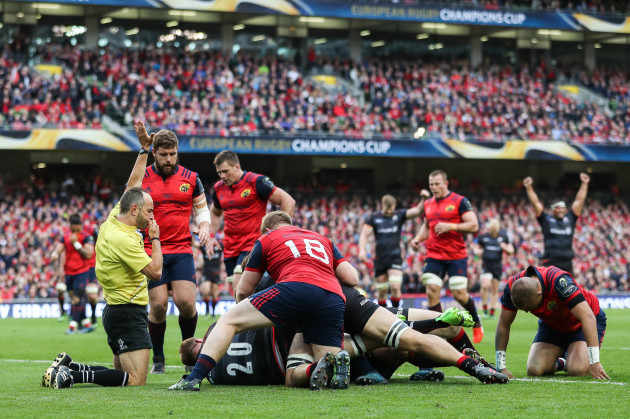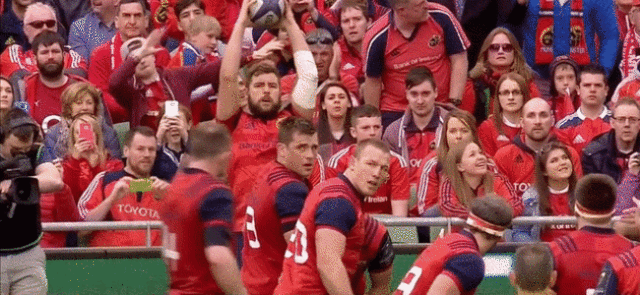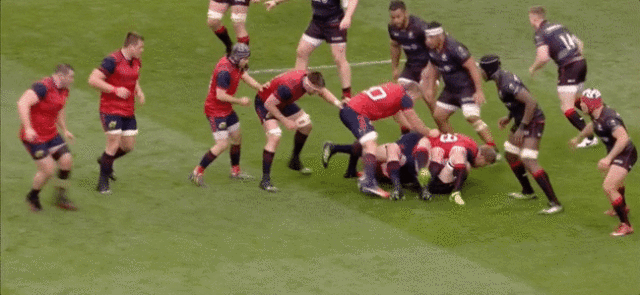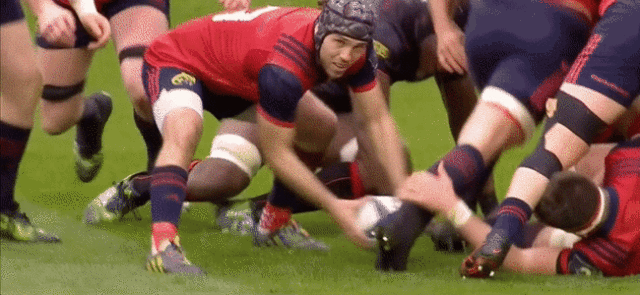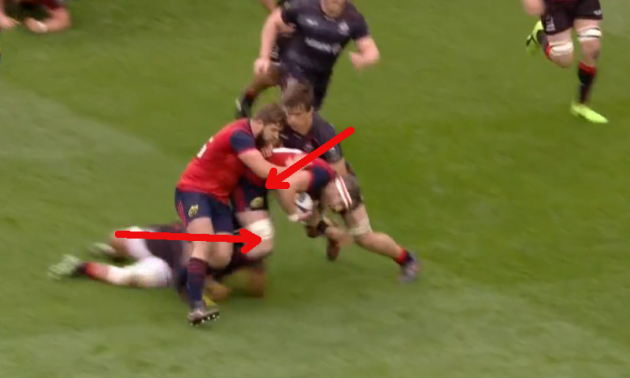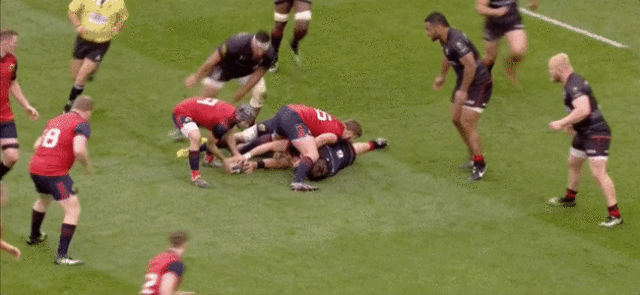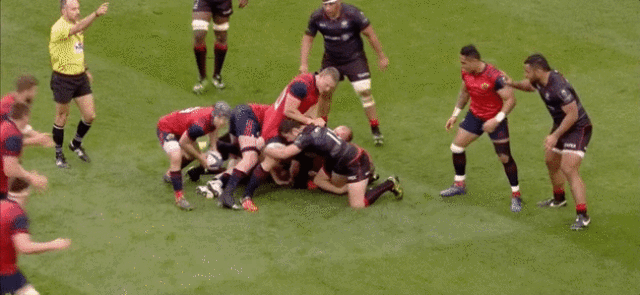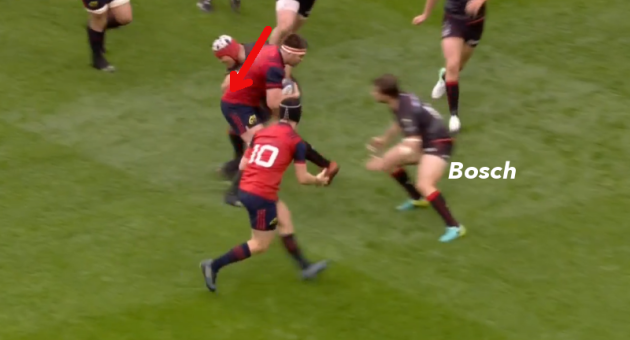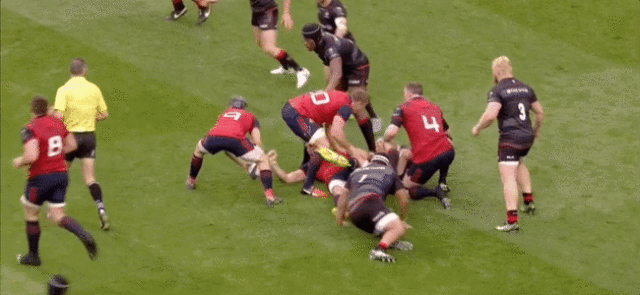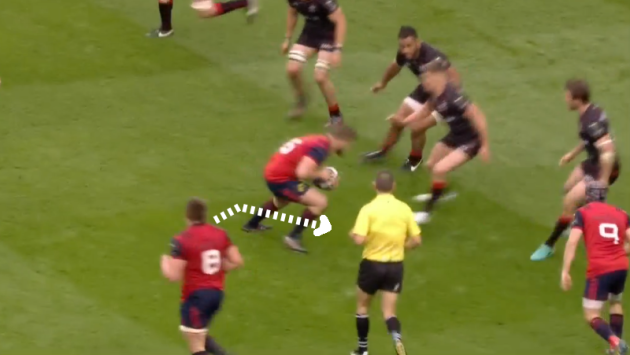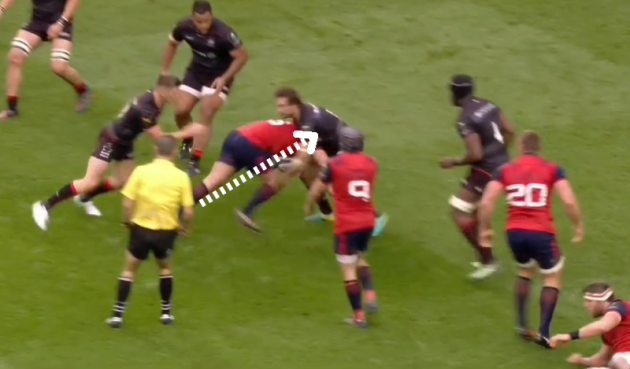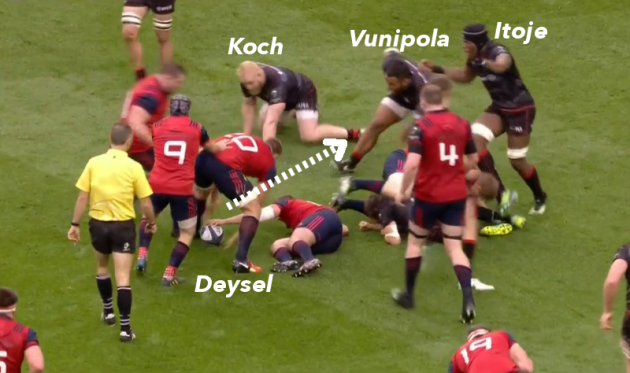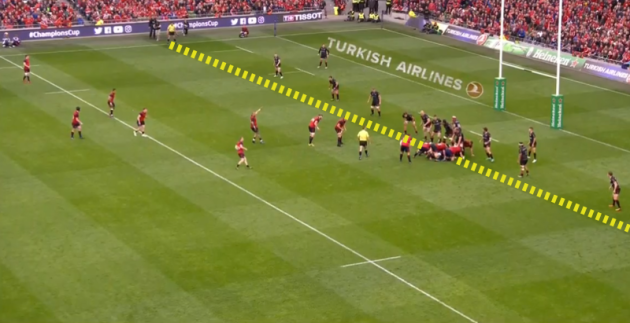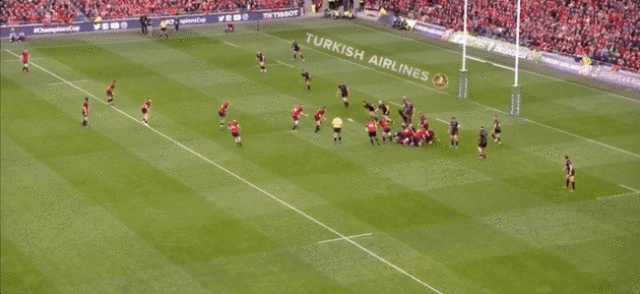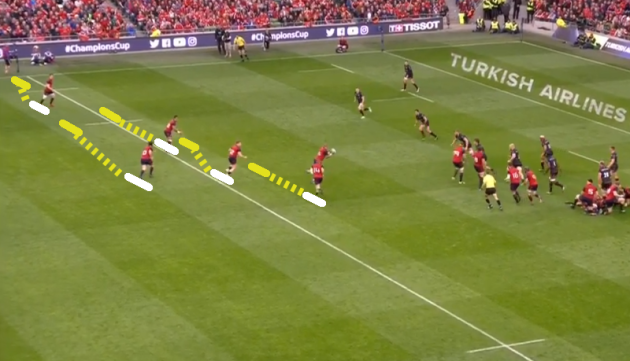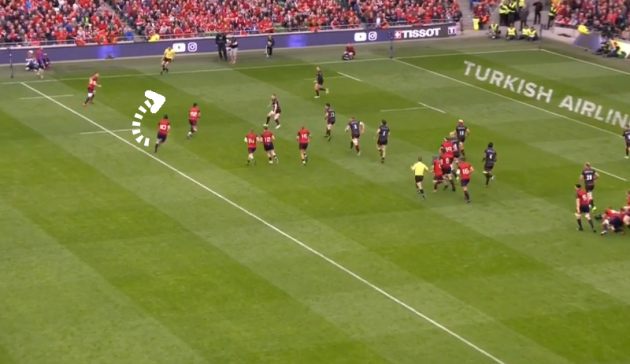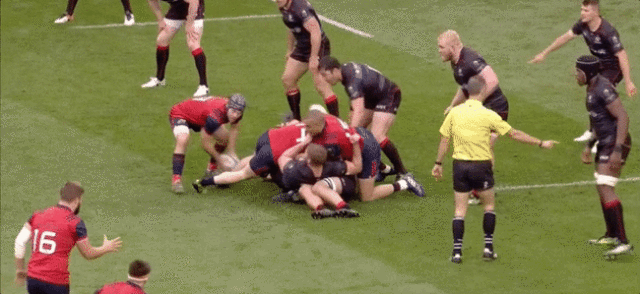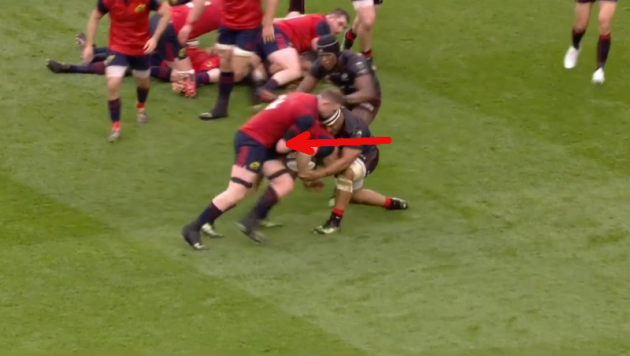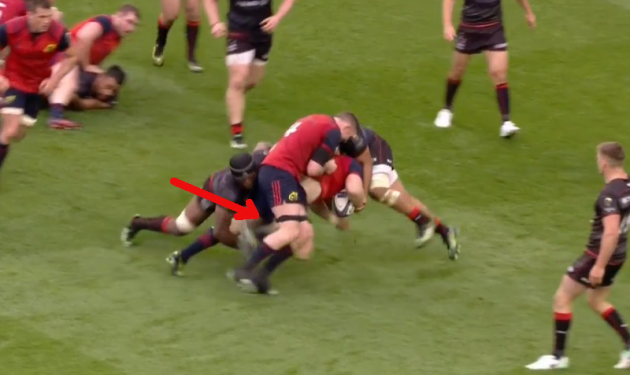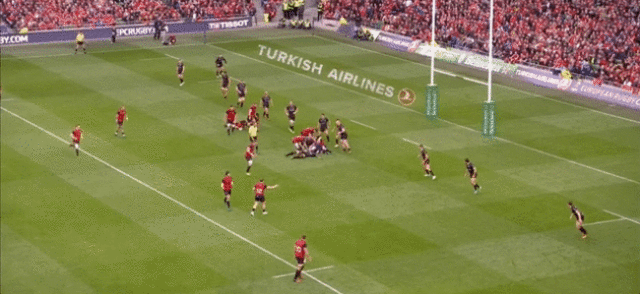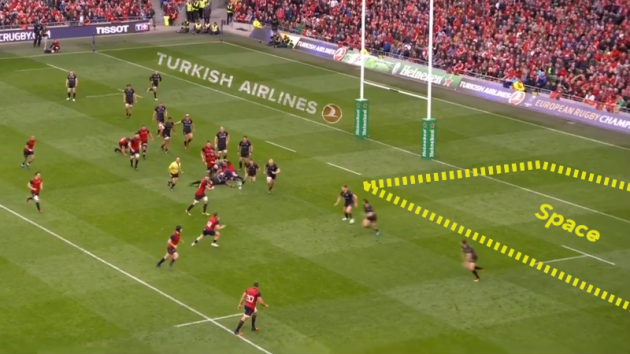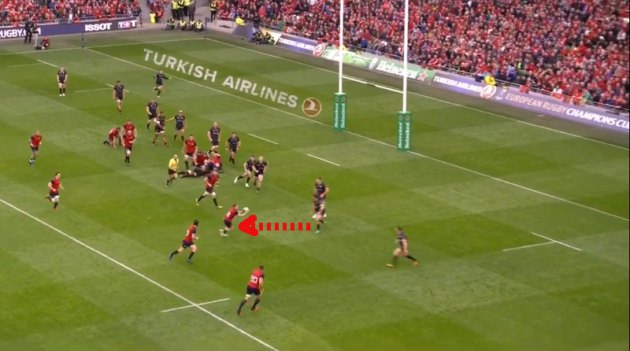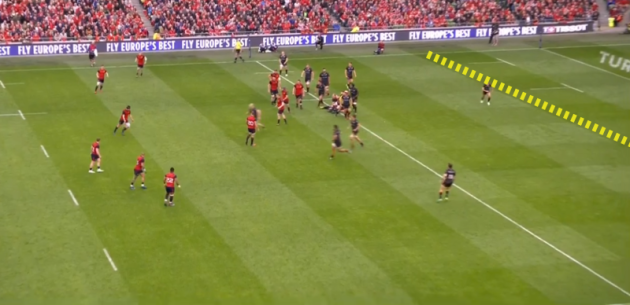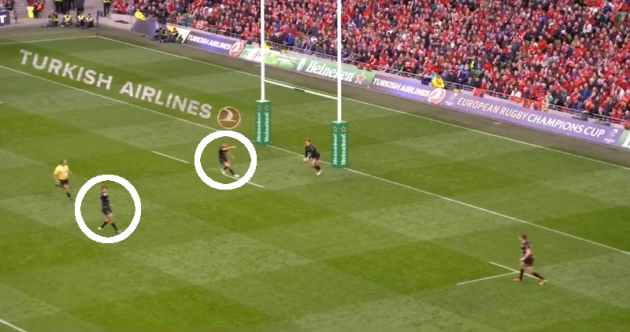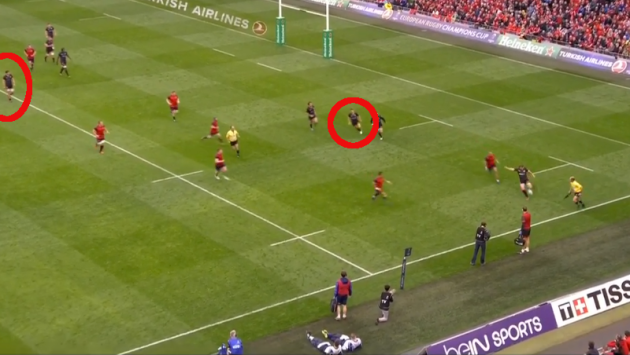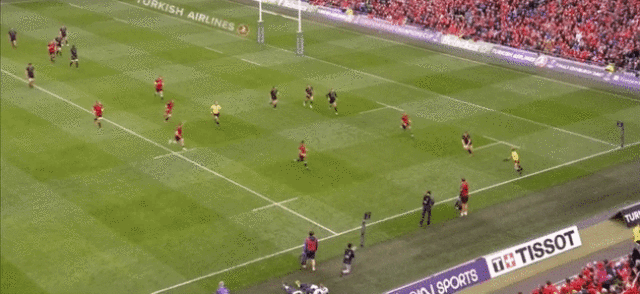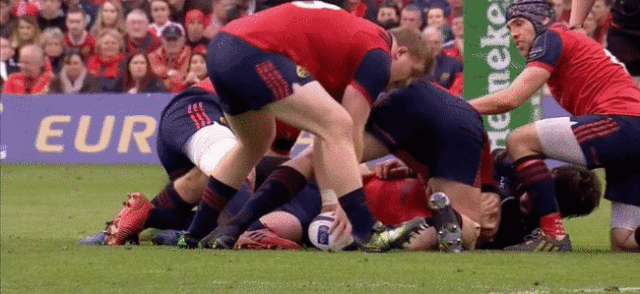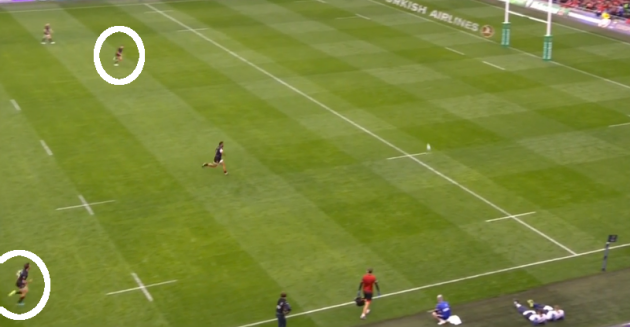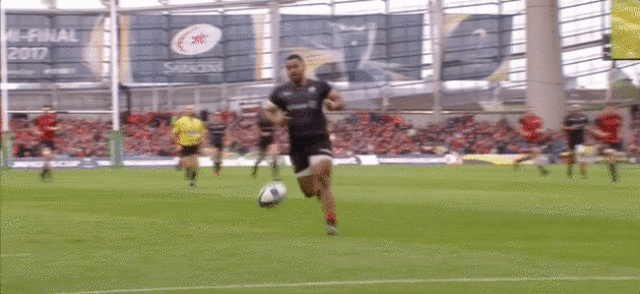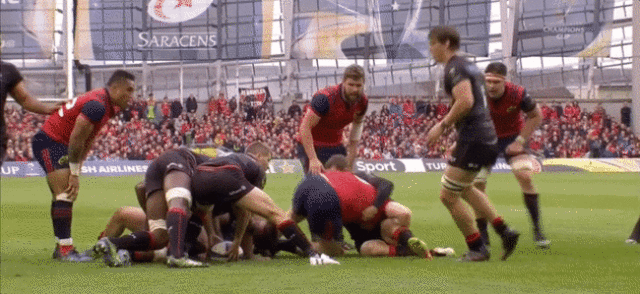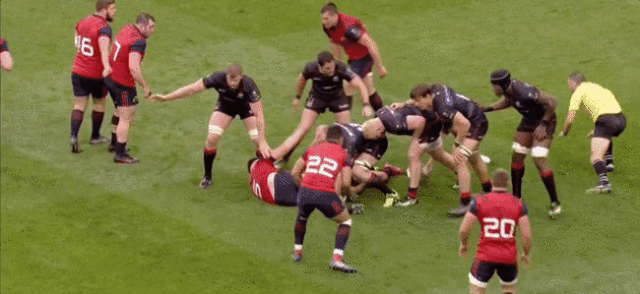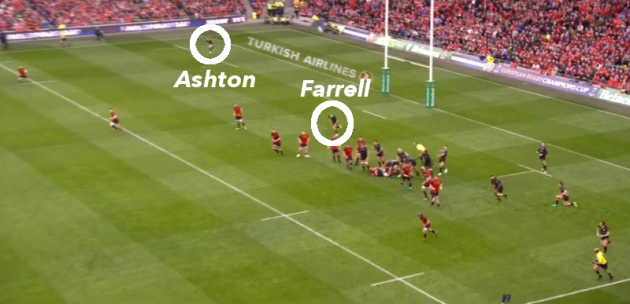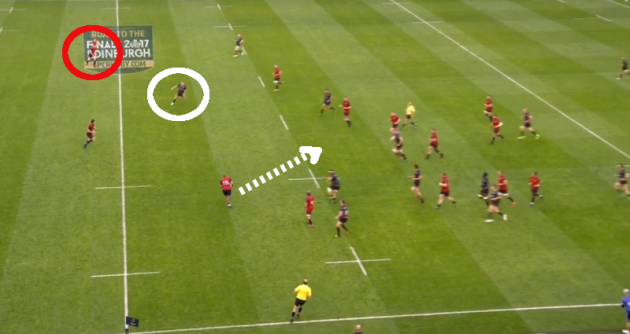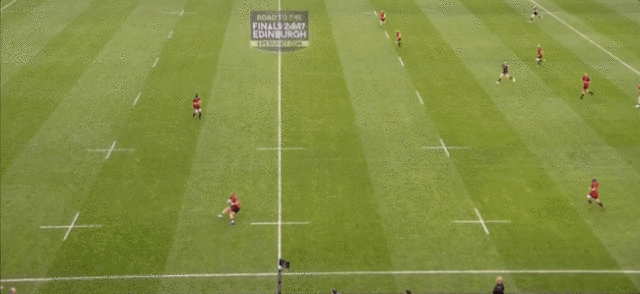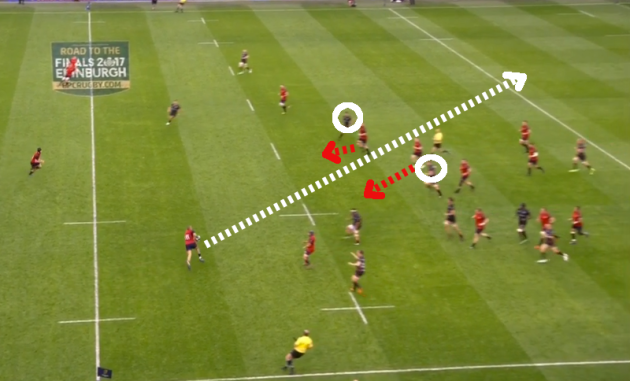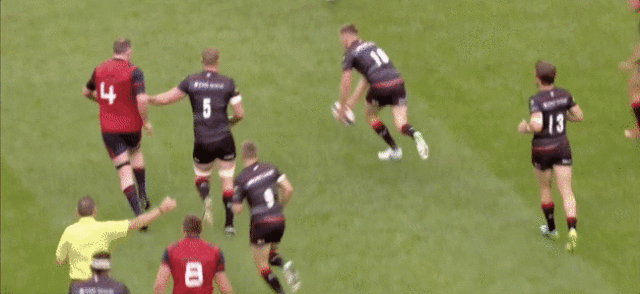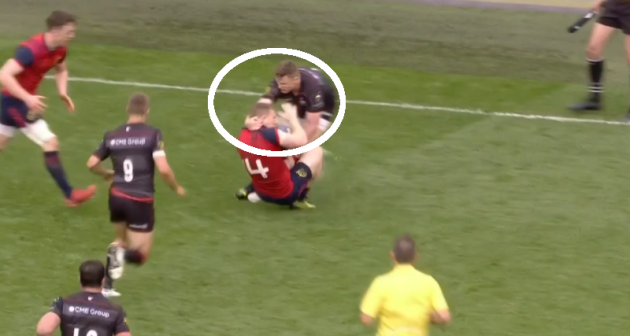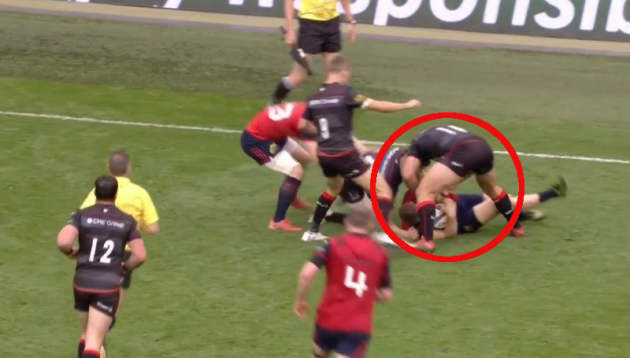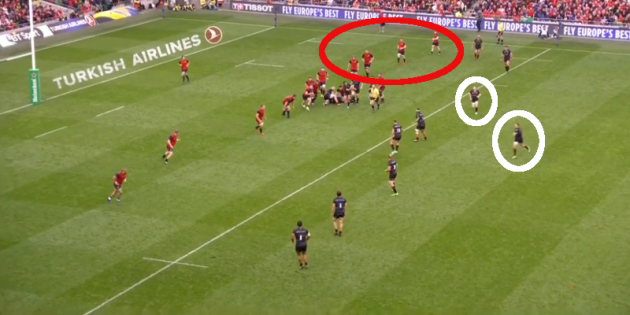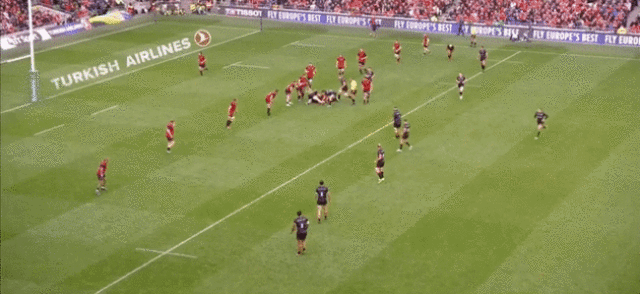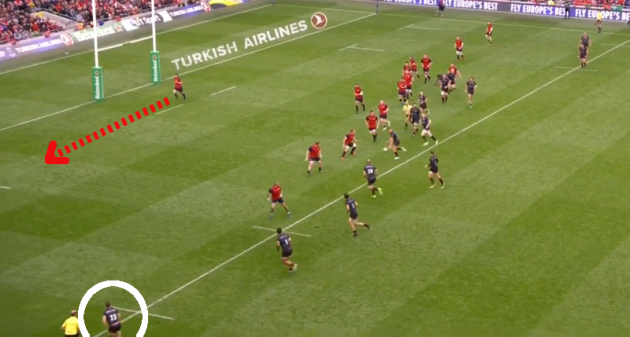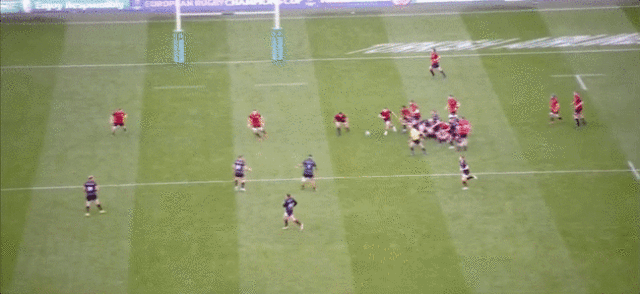SOMETIMES A SINGLE passage of play can sum up an entire game, and we saw that in the Aviva Stadium last weekend as Saracens scored their game-clinching try through sub wing Chris Wyles.
The try came from a clever Owen Farrell grubber kick, one that was all the more impressive when you consider that the ball had been in play for 3 minutes and 47 seconds by the time the England international nudged it behind Munster’s defence.
Over the course of just under four minutes of this Champions Cup semi-final, Saracens showed their ability to soak up pressure, rebound and work harder than the opposition to manufacture a superb team try.
Having the ball in play for anything longer than three minutes in top-level rugby places huge demands on players’ fitness and work rate, but Saracens came up trumps to seal their progress into the final.
This outstanding passages tells us so much about Mark McCall’s side, and also points to some of the issues Munster had last weekend at the Aviva Stadium.
Lineout letdown
Saracens lead 16-3 when we join the action in the 66th minute, just after Owen Farrell has slotted a penalty to extend their lead to 13 points.
Munster kick a penalty of their own up the left touchline to within 10 metres and, realistically, are looking at their final opportunity to turn this game around.
Unfortunately for Munster, their lineout doesn’t deliver under the pressure.
There is an issue with the timing between Rhys Marshall’s throw and Billy Holland’s jump at the tail here, with CJ Stander having to come from the very front of the lineout to lift Holland.
The Munster lock does manage to get a hand to the ball and ensure his side retain possession, but it’s a poor platform.
This was something of a problem for Munster on Saturday and, while they did steal or disrupt on Saracens’ throw, the English side’s pack certainly had the better of these exchanges as they muddied Munster’s supply of possession out of touch and in the maul.
Stand off
After Donnacha Ryan gathers the loose ball and carries, Holland arrives to pick and go, tackled by the offside-line-testing Maro Itoje.
We see that Saracens replacement hooker Schalk Brits [wearing the red and white scrum cap] jackals over the ball looking for the turnover in this instance, but we use this example only to point out that it was a real rarity from Saracens.
They were extremely selective in targeting turnovers on the deck, instead preferring to fill their defensive front line with bodies.
Filling up the defensive line naturally allows a team to come forward with more confidence and also multiplies the opportunities they have to make double tackles, where two defenders hit one ball carrier.
That said, we will see Brits have a more successful dab at turning the ball over before this passage of play ends. Picking the right battle is one of Sarries’ strengths.
Double team
On third phase, we see Munster click into the kind of attacking tactic that was a consistent feature on Saturday, with a ‘one-out’ runner taking the ball from scrum-half Duncan Williams and attempting to break the gain line.
Dave O’Callaghan is the ball carrier for Munster and it’s worth examining what he’s trying to do.
While it may have looked like Munster were simply running into bodies against Saracens, that was not the intention.
Time and time again, their one-out ball carriers looked to get to the outside shoulder of the third Saracens defender out from the ruck and drag in the fourth defender out from the ruck.
Munster knew that Saracens would bring huge linespeed in defence and, very often, those third and fourth defenders out from the ruck lead that.
Get a good carry on the angle that O’Callaghan is running above and the next phase should be much easier, with the defence forced to go a long way to fold around the corner of the subsequent ruck to re-fill their defensive line.
The issue was that Munster could not win the collisions on this carrying line, partly because of the quality of Saracens’ tackling.
Above, we can see that Mako Vunipola has gone in low to take out O’Callaghan’s legs, while Michael Rhodes has barged in high to hit the Munster back row’s upper body and tie up the ball.
While Marshall is there to offer a latch on O’Callaghan, the back row’s legs are taken out of the equation rapidly by Vunipola and therefore the Munster hooker has nothing to latch onto and drive forward.
We see similar technique from Saracens on fourth phase as Rory Scannell puts his hand up to carry.
This time it’s Schalk Burger who focuses on the legs and Brad Barritt who hits high, and again the Munster ball carrier is unable to make the kind of gainline progress that his side so desperately needs.
We go to fifth phase with Holland coming around the corner to offer himself as the carrier off nine but again Saracens make a gainline win with a double tackle.
This time we actually see the roles reversed, as the first tackler – Brits – hits high on Holland’s upper body.
Clearly, the temptation for Marcelo Bosch above is to hammer into Holland’s upper body. He’s coiled nicely for that big shot, but then shows the kind of discipline that is typical of the Saracens defence.
Bosch knows that Saracens’ system calls for one of the two tacklers to target the carrier’s legs and with Brits having hit high first, the centre dips and takes out Holland’s legs.
While a higher shot may have been more spectacular, Bosch keeps his discipline and Holland is halted well behind the gainline, another win for Saracens.
Progress
Munster shift back to their left on sixth phase and O’Callaghan carries for another negative return against the smothering Sarries’ defence, before we finally see progress.
Marshall is the man to carry on seventh phase and we see something that has not been very evident up to this point in the Munster attack: footwork.
Now, Marshall is not going to win Sidestep of the Season for this effort, but he is using his footwork to make life more difficult for the defender, Farrell in this instance.
It’s a sharp step off the left foot from Marshall and what we’re also seeing here is a player going slightly off script to adapt to the real-life demands of a game in front of him.
Munster’s game plan called for the type of carry we’ve seen above, getting to the outside of the third defender out from the ruck and tying down the fourth defender, but Marshall identifies an opportunity here and instead goes back inside the onrushing third defender.
The point is not that Munster should have stepped inside more for this type of carry – that’s a very bad idea at times and invites turnovers – but the act of reacting to the situation is a positive from Marshall.
The hooker straightens back up and powers into a slight mismatch against a back, Bosch, and finally Munster have made a genuine gainline carry.
Stephen Archer thunders in to resource the ruck and goes off his feet, but referee Romain Poite is content that “no one is in the contest” for Saracens – i.e. no one is looking for a turnover – and allows play to continue.
Suddenly, we see the value of gainline progress, as Vincent Koch loses his feet after tripping on the retreating Bosch, in turn causing Billy Vunipola to stumble.
Jean Deysel doesn’t need to be asked twice. He picks and carries into the chink of space in front of him.
Vunipola and Maro Itoje compete for the turnover but James Cronin, Donnacha Ryan and Archer do excellent work on the clearout.
Again, Munster have made fine progress up the pitch, stemming back to Marshall’s ability to use his footwork and change the picture for the defence.
In reality, Munster are back to exactly where they started from the lineout, as we can see above, but these two positive carries have tightened up the Saracens defence and the Munster backs are calling for the ball and the opportunity to strike wider.
Making it count
Munster’s backs got very few opportunities of this nature to strike after their forwards had made gainline progress, so it’s vital that they make it count in this instance.
It’s not a gilt-edged try-scoring chance, but Munster have their full backline to the left of the ruck and are numbers-up against the Saracens defence.
The Munster backs have had two phases on those Marshall and Deysel carries – the second of them involving a ruck that lasts longer than six seconds – to get themselves set and make a good play call, but they don’t appear to have done so.
There’s a skip pass from first receiver Simon Zebo beyond Scannell to Francis Saili, but that simply serves to remove three of the Munster players from the situation, squashing their numerical advantage in a second.
Let’s imagine how much more threatening Munster could be here if their backs were set-up wider.
So instead of their actual starting positions as indicated by the white marks above, let’s imagine that the Munster backs had all worked wider to the yellow markings.
Things would be looking a lot more threatening for the Saracens defence. Munster would have beaten them for width and there would have been more scope to simply move the ball through the hands, drawing and passing, or to use Andrew Conway and Tyler Bleyendaal as the ‘second wave’ attackers behind decoy runs.
Instead, there’s a skip pass and Scannell, Conway and Bleyendaal are removed as threats.
The ball ends up in Saili’s hands and there’s no real threats around him to lure defenders away. Darren Sweetnam is on his left, but he’s well covered by last defender Alex Goode.
Bleyendaal might wonder whether he could have burst to Saili’s outside shoulder on the line above earlier, giving Chris Ashton a tougher decision to make, but he only arrives there after Saili has tucked the ball into one hand and decided to carry.
As ever, it’s easy to point these things out in hindsight with the benefit of multiple replays, but Munster’s backs must place greater demands on themselves – particularly in games where these front-foot ball chances are such a rarity.
Back to the grind
By now, Munster are into 10th phase and they switch back to the right for a rather familiar sight.
There’s another double tackle from Saracens, Burger the man to go low as Billy Vunipola goes high, and once again the result is negative yardage for Munster.
Archer gets a good latch from Ryan on the next phase, but again we see excellent tackle technique from Saracens.
Mako Vunipola goes in on Archer’s upper body.
But with Ryan latching on, it’s a 2-on-1 for Munster and there’s a real threat of a damaging carry here.
Maro Itoje is the second Saracens tackler and the temptation must be to hammer in high on the contest.
Instead, he goes in around Archer’s left leg and brings the tighthead to ground.
It’s another good Saracens tackle but opportunity knocks for Munster once again on the next phase as space suddenly shows.
Can you grubber?
Rather presciently, BT Sport commentator Nick Mullins says “it’s got the feeling of a huge moment in this semi-final” as Munster recycle the ball following Archer’s carry.
On the very next phase, there is clear space for Munster but they don’t have the right pieces in place to exploit it.
Scannell is the first receiver for Munster and we can see that the space is wide open in behind the Saracens defence.
We’ll soon see how Saracens take advantage of such space, but Munster aren’t able to do so here.
Damagingly, they don’t have a player holding width over on the right touchline. Had there been someone in that position, Scannell probably has the skill level to execute a grubber in behind Saracens.
Even without someone there, there is some prospect of Scannell dinking the ball in behind for Deysel to chase, but Bosch does superbly here to shut down the Munster centre’s options.
Acknowledging the danger, Bosch comes up with huge linespeed – Saracens don’t know any other way – and Scannell is under intense pressure.
He does have time to catch the ball and there is a brief window open for him to slip a short pass to Bleyendaal arriving on his right shoulder, but Bosch makes life so difficult by rushing up hard and then chopping him immediately to ground.
This has to be seen as an opportunity for Munster – can they get an extra body wide next time? Can Scannell drop that short pass off to Bleyendaal? – but Saracens once again make everything more difficult with their brilliant defence.
Pot shot
The belief drains out of Munster as Saracens continue to defend with technical quality, intimidating communication and work rate, as the Irish province lose more ground over the next few phases.
They almost knock-on through Stander, before absent-mindedly allowing the ball to roll out of a ruck, only to recover, but by the 19th phase they are a spent attacking force and Bleyendaal drops into the pocket to attempt a drop goal.
It’s notable how far behind the gainline Bleyendaal is when he kicks, but also how narrow Munster are. The entire team is essentially inside one half of the pitch, with the fatigue of multi-phase attack having set in.
Bleyendaal’s drop goal effort is a tired one and it hits the padding on the right post.
Munster don’t chase particularly hard – Zebo is the man leading the way – and they are probably hoping Sarries will clear to touch in order to allow them to regather before launching another set-piece attack, but the English side have other ideas.
Pushing the limits
When Goode gathers possession, the ball has already been in play for over two minutes, during which time Saracens have expended a large amount of energy defending.
Any thoughts of kicking to touch are rapidly overridden by Richard Wigglesworth and Bosch, both of whom are circled below.
Wigglesworth and Bosch have both identified how narrow Munster are just after Bleyendaal kicks and they spot the space wide on the left side of the pitch as they glance upfield.
We can see them both directing Goode to pass wide left to the waiting Wyles, who has space in front of him.
Zebo and Saili do cover across after Goode passes, but USA international Wyles gets a long kick away and we see another strength of Sarries’ come into play.
Wigglesworth is the primary chaser for Saracens here – what some teams call the ‘sniper’ – and he is circled in red behind kicker Wyles above.
When we watch the clip below, Wigglesworth’s pure work rate is apparent as he sprints upfield.
Following behind is blindside flanker Rhodes, who hammers in high on Bleyendaal after Wigglesworth has made a brilliant low tackle on the Munster out-half.
It’s impressive effort from Saracens after such a long defensive set, but this passage of play is not over yet.
Retreat
Saili kicks immediately back in behind Saracens, a clever kick into space, where Billy Vunipola carries and offloads to Bosch.
While it appears that Munster apply some pressure on Saracens in this instance, we must again note the effort from Saracens.
Vunipola is closest to the ball but it’s Bosch, bottom left above, and Farrell who we are more interested in.
Again, it’s about work rate. Both players demand more of their bodies as they retreat, not allowing any Munster players to beat them to the scene. It’s worth remembering this effort as we continue.
Vunipola gathers the ball and beats Saili. It may seem like a risky decision but he has support from Farrell and Bosch.
Apparently, Saracens are still full of energy as Vunipola counters and Farrell runs a short line on his right looking for an offload.
Bosch is in position behind the number eight to accept the pass out of contact.
Saracens look to their forwards for a ball-carrying phase as they build towards their exiting kick and, rather tellingly, we see the kind of carry that Munster had been so desperate to produce during their 19-phase attacking set.
Brits is the man to carry for Sarries and we see the important facets of any carry.
The hooker uses his footwork to get to the outside shoulder of the third man out from the ruck. He also changes the pace of his run, truly bursting into an acceleration as he targets the space. And, finally, there is the use of one of his key ball-carrying tools – the fend on James Cronin.
It’s only a short gain but this carry is in contrast to many of Munster’s.
Exit
Wigglesworth box kicks from the base of the subsequent ruck and while it seems obvious that Saracens would finally be ready to get the ball off the pitch, it stays in play here.
It’s unclear whether this is a tactical choice from Saracens, but what is very clear is how well they respond to the ball staying in play.
Farrell and Ashton are the key chasers to the right of the kick.
It’s worth briefly noting how wide Ashton starts here – Saracens’ openside wing almost always holds that width, as will prove essential to Wyles scoring.
But Farrell is the key man on the kick chase here and his work rate is again eye-opening. He ducks his head and demands another sprint from his body, passing three Munster players on his way.
While Darren Sweetnam and Andrew Conway [circled in red below] work hard to retreat and provide options wide on Simon Zebo’s left, Farrell [white] essentially severs off that option for Munster.
Almost like a good Border Collie, Farrell’s work rate and positioning guide Zebo where Saracens want him to go – right back into the pen of bodies arriving upfield.
The Munster fullback does actually break Brad Barritt’s tackle, but Burger immediately swarms onto him and forces the ball loose for a turnover.
Could Munster have done more to help Zebo in this instance?
Well, we can see that Donnacha Ryan is signalling to him as he retreats, apparently inviting the fullback to return the Saracens kick into that space.
What the fullback really requires are retreating Munster players to subtly steer defenders onto a path that will open clear space for Zebo to run into.
Imagine, for example, that Ryan and Scannell retreat on the red lines indicated above, opening up a channel for Zebo to run into in between Barritt and George Kruis [circled in white].
It’s a fine art and runs the risk of conceding a penalty for blocking but this is also a key part of any kick return. It doesn’t happen for Munster, however, and Zebo loses possession as he hits contact.
Kruis cleverly taps the ball along the ground to Farrell and the Saracens out-half kicks deep to allow them to complete the role reversal and apply huge pressure on Munster.
Territory
Farrell isn’t hoping to bounce the ball into touch here, keen as he is to allow Saracens to pressurise Munster into an error.
Again, we must stress the quality of Saracens’ work rate here. Ashton is the ‘sniper’ on this occasion and it’s apparent just how fast he is sprinting on the chase.
The Saracens wing starts his chase 10 metres behind both Sweetnam and Williams but beats both of them easily to get to Conway after he gathers the ball in Munster’s 22.
It’s a contrast to earlier in the passage when Bosch and Farrell ensured that no Munster player beat them on their retreat to support Vunipola.
Conway is left under pressure in his 22 with no team-mates behind him and looks to run the ball out, getting turned over in the process.
We must note that Ashton tackles Conway around the neck but it appears that even the officials are feeling the heavy fatigue at this point and play continues.
Brits, following up behind Ashton, wins the race to the ball.
He jackals to win the turnover, with Ashton cleverly getting back to his feet just in front of the ball, and Poite roars at Sweetnam to release as he attempts to wrestle possession back from Brits.
Turnover complete, Saracens’ mindset instantly switches to scoring.
We can grubber
Itoje makes a thundering carry to the left as Saracens go on the attack, tying down three Munster defenders, before Farrell gets on the ball and nudges a beautiful grubber behind the Irish province.
Once again, we must note work rate when it is so apparent. Even before Farrell kicks the ball, we can see Ashton and Goode working hard to get around the corner and join the attacking line.
Saracens already have an overlap and Ashton and Goode [circled in white above] won’t be needed here, but their work rate under huge fatigue still stands out.
Meanwhile, Munster are over-stacked on their left side of the ruck, marking up four defenders [in red] on only two attackers.
The grubber kick from Farrell, three minutes and 47 seconds after Marshall’s original lineout throw and after some huge sprints from the out-half, is perfect.
The space – as with Munster’s brief chance earlier – is clear, but crucially Farrell has a player holding the width in order to chase a grubber kick.
Wyles, circled in white below, has indicated the space and called for the kind of grubber that Saracens specialise in. We spoke about their grubber tendencies last week and Farrell is one of the men who lead the way in this regard.
Bleyendaal is the backfield cover for Munster here and he needs to be sprinting across the pitch [red] if he’s going to have any chance of covering the kick here.
But the intense fatigue has set in and the Kiwi out-half can’t find the energy to move faster.
Munster’s outnumbered frontline defence cannot apply enough pressure on Farrell before he kicks and it means the England international can accept a pass from Mako Vunipola and calibrate the weight of his kick ideally.
The fact that Vunipola simply catches and passes to Farrell is important too, when some tight forwards might have carried the ball in this situation.
Wyles, fresher than most on the pitch, chases hard and collides with Zebo, forcing the ball loose.
There is an element of fortune in how the ball bounces up into the Saracen wing’s hands, but sometimes fortune favours the hard-working.
The42 is on Instagram! Tap the button below on your phone to follow us!
